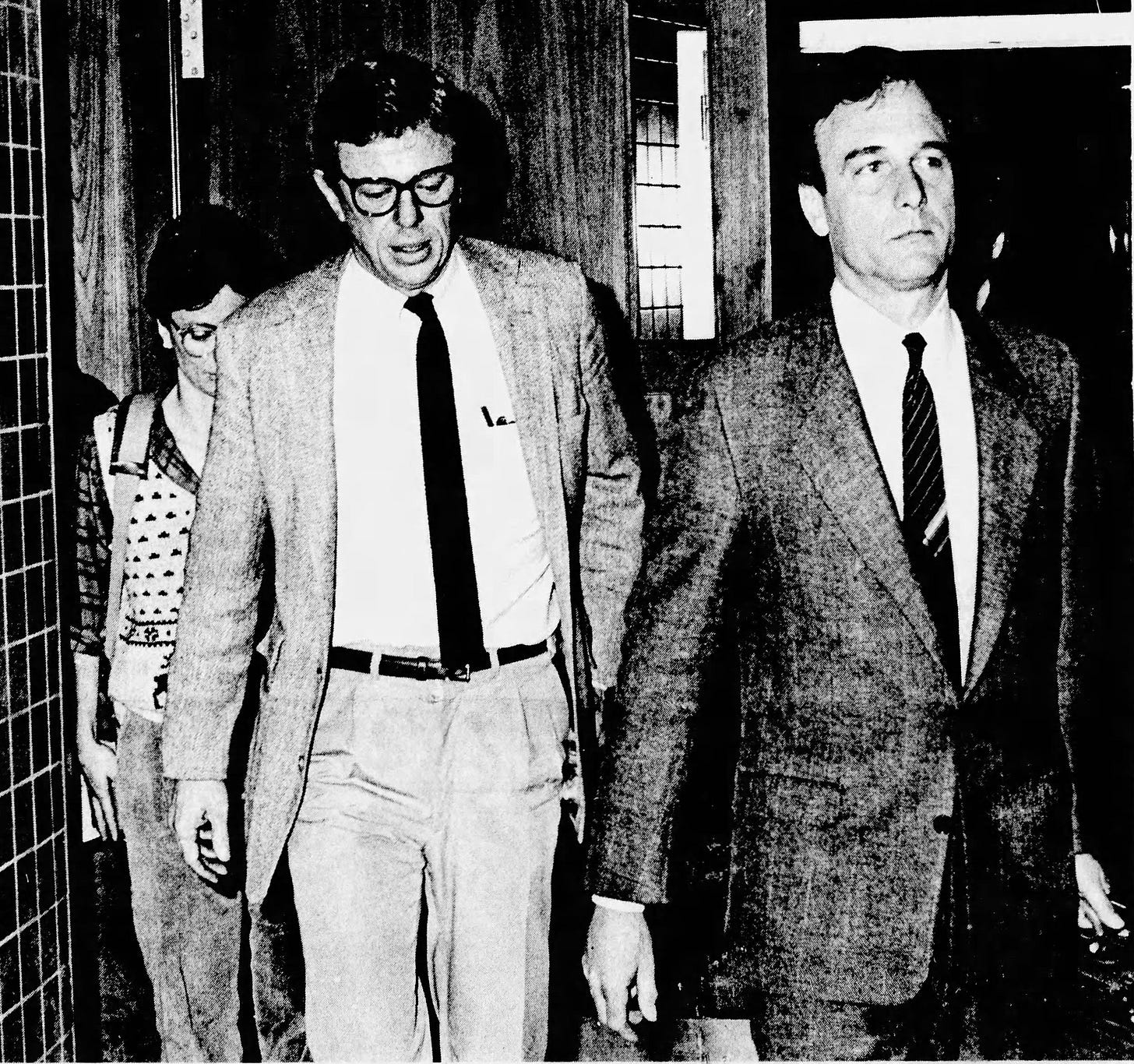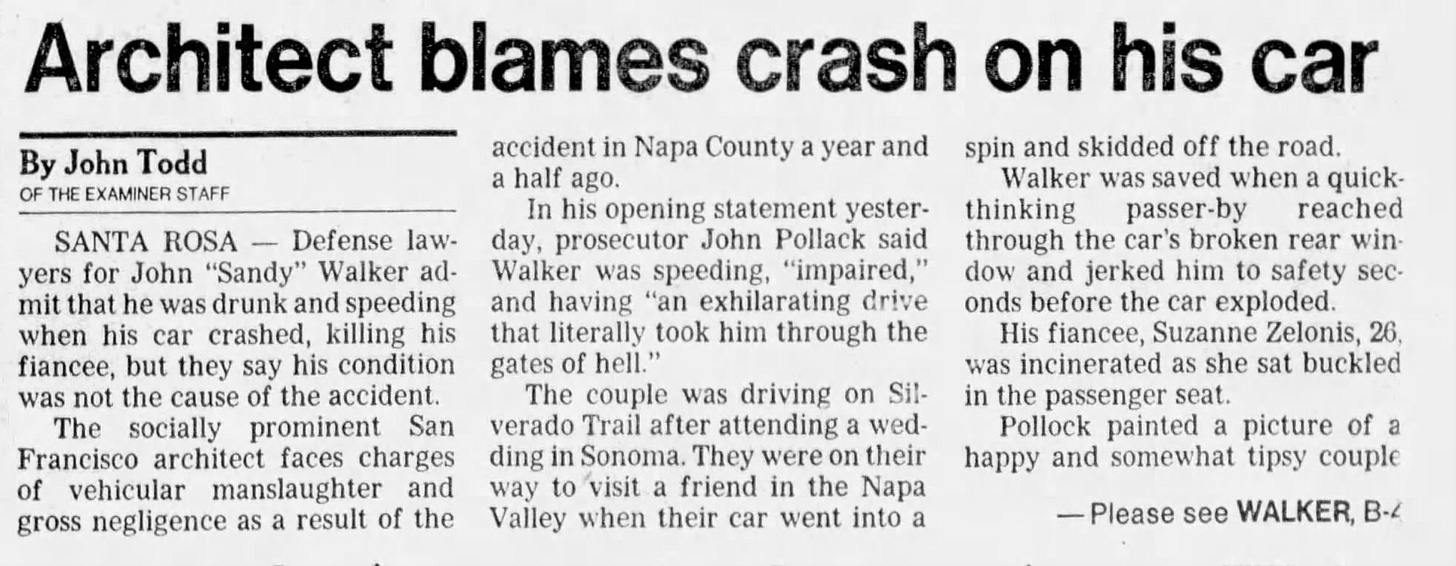Book Excerpt: Cult of GT-R, Chapter 6
Inside the forgotten trial that gave us the 25-year import law
Welcome to our weekly installment with excerpts from Cult of GT-R, my newest nonfiction book about the history and controversy of the Nissan Skyline GT-R, available now. Every Monday, I’ll post a short section from a different chapter, plus photos and commentary, to give you a taste of what’s in the book. Click here to read previous excerpts from Chapter 1, 2, 3, 4 and 5.
To buy Cult of GT-R, click here for my website or find it at your favorite online retailer. Enjoy!
Cult of GT-R: Chapter 6 Excerpt

THE ACCIDENT THAT CHANGED THE CAR WORLD FOREVER happened in June of 1984, when a Mercedes 500 SEC suddenly careened off the road in Napa County, California. The two-door luxury car became airborne, then slammed into not one, but two oak trees. A fire started. The Mercedes smashed through a chain-link fence and finally came to rest in a grassy field. The blaze grew in intensity. A witness would later say the car “lighted up inside,” and then exploded. Sadly, a young woman named Suzanne Zelonis was still in her seat. She died at just 26 years old.
Zelonis’ boyfriend, however, was miraculously saved. The accident had thrown him, unbelted in the driver’s seat, into the car’s back row. That allowed an anonymous bystander to reach through the rear window glass, grab his hand, and yank him out of the car moments before the explosion. Disoriented, his hair singed and clothes tattered, he staggered away from the burning husk of the Mercedes. He collapsed in the grass next to a shocked woman who’d pulled over to help. As he waited for the ambulance, he asked if anyone else had made it out of the car. No, she told him. A few moments later, he asked her again.
As they sat, the woman learned that the man was John “Sandy” Walker, a prominent San Francisco architect. At 56, he was thrice-divorced and a regular in the posh Pacific Heights party scene. He was Zelonis’ fiancée, as well as her boss—after graduating from UC Berkeley, she had been hired at Walker & Moody, which Walker had helped build into a high-profile firm for homes, restaurants and other signature buildings throughout California.
The woman also noticed that Walker had an odor on his breath. Like alcohol. Investigators would later learn that he and Zelonis had attended a wedding earlier in the day, drinking champagne. They then stopped by an afterparty, drinking wine. At the hospital, Walker’s blood alcohol level was 0.14, over the legal limit of 0.10.
Prosecutors threw the book at him. They issued charges of felony manslaughter and felony drunk driving. Walker drew little sympathy: a highway patrolman estimated the wealthy socialite was traveling between 114 and 133 mph on the country back road. Walker’s fiancée, 30 years his junior, was burned beyond recognition. Her identity could only be confirmed through dental records.
“It could have happened to anyone,” he said. “It could have happened to you.”
In trial, prosecutors painted Walker as the pampered son of a prominent, privileged family. An old friend described him as “One of the Golden Boys,” and Walker’s third wife said he was the kind of person who “always has someone to come along behind and clean up [his] messes.” His own actions seemed to confirm this in the minds of many. The woman who waited with Walker in the grass, while Zelonis’ body burned inside the Mercedes, remembered that “he seemed pretty sad about his car.”
The only person in Walker’s corner, it seemed, was his attorney. John Keker, a Princeton and Yale graduate who would later prosecute Oliver North in the Iran-Contra scandal, searched for any possible angle to gain sympathy. He had the trial moved from Napa County, where locals were angered by drunk out-of-towners treating the roads like their personal playground, to Sonoma County. He tried to have the results of the sobriety test thrown out. He even cast doubt on whether Walker had been the one driving in the first place. None of it worked.
But Keker wasn’t done. In a moment that would echo far beyond that Sonoma courtroom, he made a new claim: The crash had nothing to do with speed or inebriation, he said. It happened because Walker’s Mercedes, a gray-market import, had been improperly modified by a conversion shop. In fact, Keker alleged, the work was the product of a notorious gray market grifter whose shop’s labor had caused the Mercedes-Benz’s computerized brake system to malfunction and catch fire, throwing it into a skid and off the road.
Drunk or sober was irrelevant, Keker said. The crash was the result of shoddy workmanship by the conversion shop owner, a convicted felon. No one could have prevented it.
The prosecution vehemently argued this narrative. To bolster his case, Keker called on Paul O’Shea, an “accident reconstruction specialist” and three-time national racing champion. Years earlier, O’Shea’s testing of the Chevrolet Corvair had informed Ralph Nader’s landmark 1965 book on vehicle safety, “Unsafe at Any Speed.” Keker paid O’Shea $1,000 per day for his testimony. Unlike the authorities, O’Shea had gained underhood access to Walker’s Mercedes after the crash. The car, he testified, “went out of control” due to “a malfunction of the braking system.”
Armed with that, and with a client who conveniently couldn’t recall much of the event in question, Keker laid into the jury. In his closing argument, he looked at each juror in turn, and lambasted the gray-market conversion industry. “It could have happened to anyone,” he said. “It could have happened to you.”
On February 7 , 1986, John Clinton “Sandy” Walker was found not guilty of vehicular manslaughter. The defendant, journalists noted, “sighed and smiled” at the verdict. At the time, anyone found innocent of manslaughter in California could not be tried for felony drunk driving in the same incident, so Walker had beaten both charges. On his way out of the courthouse, he showed a flash of empathy. “I appreciate this,” he told the assembled media, “but it doesn’t change the tragedy of Suzanne’s death.”
Public opinion was little swayed. A spokesperson for Mothers Against Drunk Driving said “justice was not done,” and a letter to the editor of the Napa Valley Register scorned, “Once again we are witness to what money can do... no justice, indeed.” As for Keker, some of his friends reportedly stopped speaking to him, but his client was free. And regardless of what anyone thought, the legal record would forever hold that the car was to blame.
About This Chapter
What can I do, I wondered as I was writing this book, to really take it above and beyond? I knew plenty of folks were aware of the 25-year law. I knew most enthusiasts understood its impact. But I knew I had never heard the inside story.
This trial is the true turning point in the history of the 25-year law. Without the gruesome death of Suzanne Zelonis, and the subsequent acquittal of Sandy Walker, the 25-year simply would not have become reality.
Automakers had tried for years to force an importing ban through the political process to no avail. They tried framing it unsuccessfully in various lenses, but when they were able to portray it as a safety issue, using the unwitting perspective of an innocent, all-American 26-year old woman as a victim, they pounced on it.
The story of the Nissan Skyline GT-R, and the story of the Imported Vehicle Safety Compliance Act of 1988, are stories of unintended consequences. No one could have predicted that any of these circumstances would lead to one another. And they were not pre-ordained. Instead there are very concrete moments in time that deserve to be mentioned and should not be forgotten. The tragic tale of Suzanne Zelonis is one.
The reporting in this chapter would not have been possible without the dogged journalism conducted originally between 1984-1986 in the San Francisco Examiner and especially in the Napa Valley Register. The work published in those pages made an indelible mark on my efforts and is a reminder that good journalism lasts decades, and is a worthwhile community service. We should treat it as such.
I am saddened by the way we have treated community journalism in recent years. We have degraded and devalued it down to nothing. We have made it susceptible for vultures to fly in and pick at its bones, using the disingenuous guise of profitability and shareholder value to discard hardworking reporters as unwanted sinew. My hope is that Cult of GT-R presents the value in traditional journalism at its roots. May we remember that it was the automakers and the court system that acquitted Sandy Walker and used Suzanne Zelonis as a chess piece, and the reporters who told the truth. And preserved it for us to understand, for our benefit, today.
Check out Carrara Media on Instagram, Twitter and Facebook and visit our store to order one of our many fine books and eBooks.





Thank you for a great excerpt! I particularly appreciate your rumination's on the nature of journalism and it's role in the world we live in. A good journalist has the opportunity to portray with comprehensive subtlety the complex issues surrounding events and allow the reader to come to his or her own conclusion based on reflection. The world is a poorer place for the decline.